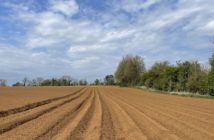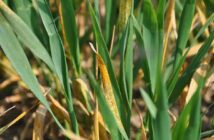The UK is primed for a mass eruption of phoma leaf spot spores during early to mid-October, according to experts.
This warning was issued alongside the critical October update of the AHDB Cereals & Oilseeds-funded phoma leaf spot forecast.
Hosted by Rothamsted Research, the forecast uses temperature and rainfall data (from the summer to early autumn period) to provide information on potential disease pressure and guide spray decisions against phoma.
With plenty of rain throughout August and unsettled conditions predicted for the foreseeable future, all UK regions are forecast to be at risk from a mass eruption of airborne spores during early to mid-October.
Due to the importance of localised rain/wetting events, the timing of visible leaf spot symptoms is forecast to vary tremendously across the UK.
Compared to last year, some sites are forecast to have earlier onset of symptoms, some similar and some later.
Phoma life cycle
Phoma stem canker is caused by two species of fungi: Leptosphaeria maculans and L. biglobosa.
In autumn, fungal spores are released from infected crop stubble.
The spores infect young susceptible leaves which then develop the characteristic leaf spot.
Fungi grow from the leaf into the leaf petiole and then infect the plant stem – the smaller the plant, the quicker this step can occur.
Once in the stem, the fungi kill tissue causing visible phoma stem cankers in the late spring and through the summer.
Cankers caused by L. maculans are generally associated with the stem base and are considered to be more severe than the upper stem lesions often associated with L. biglobosa.
The forecast is based on L. maculans development.
Phoma management
Bearing in mind the current UK risk, growers are being advised to keep an eye on the phoma leaf spot forecast website to track local risk.
Dr Neal Evans, Weather INnovations Consulting LP, who puts the forecast together, said: “The UK forecast map is based on more than 80 sites and is updated daily to show when each site is predicted to have 10% leaf spotting, which is the established threshold for treatment.
“Thus, the map can guide spray decisions but, as localised rain events play such an important role, nothing beats walking the crop and inspecting the leaves.”
Varietal resistance
Oilseed rape can resist attack by phoma with single ‘Rlm’ gene resistance in the leaf or multiple gene resistance in the petiole and stem.
Dr Jenna Watts, AHDB Research Manager, said: “Rlm genes can be very effective in managing disease and varieties with a disease resistance rating of 8 or 9 are likely to contain these genes.
“Backward crops with a low disease rating, particularly the 3s and 4s, should be the priority for treatment.
“However, phoma populations have the potential to change rapidly and render Rlm genes ineffective, so it’s important to monitor all crops, even those with a high disease rating.”
Phoma control is, typically, based on a two-spray programme of triazole fungicides.
Fungicide performance information against phoma will be updated in the next few weeks.
In 2014, it was found that good control of phoma can be achieved with two sprays at half rate.
Early treatment is critical as once the fungi move from the leaf to the petiole and stem, the window of opportunity for the first spray closes.
A second spray should be made when re-infection is evident – typically four to ten weeks after the first spray.
The forecasting project also receives funding from Bayer CropScience.



